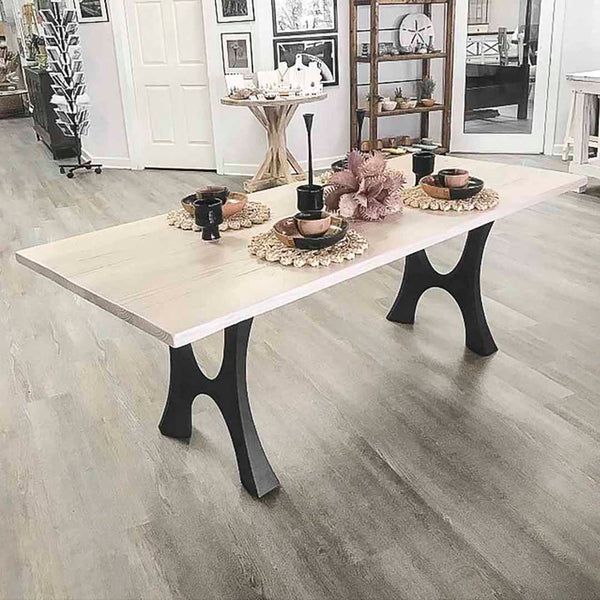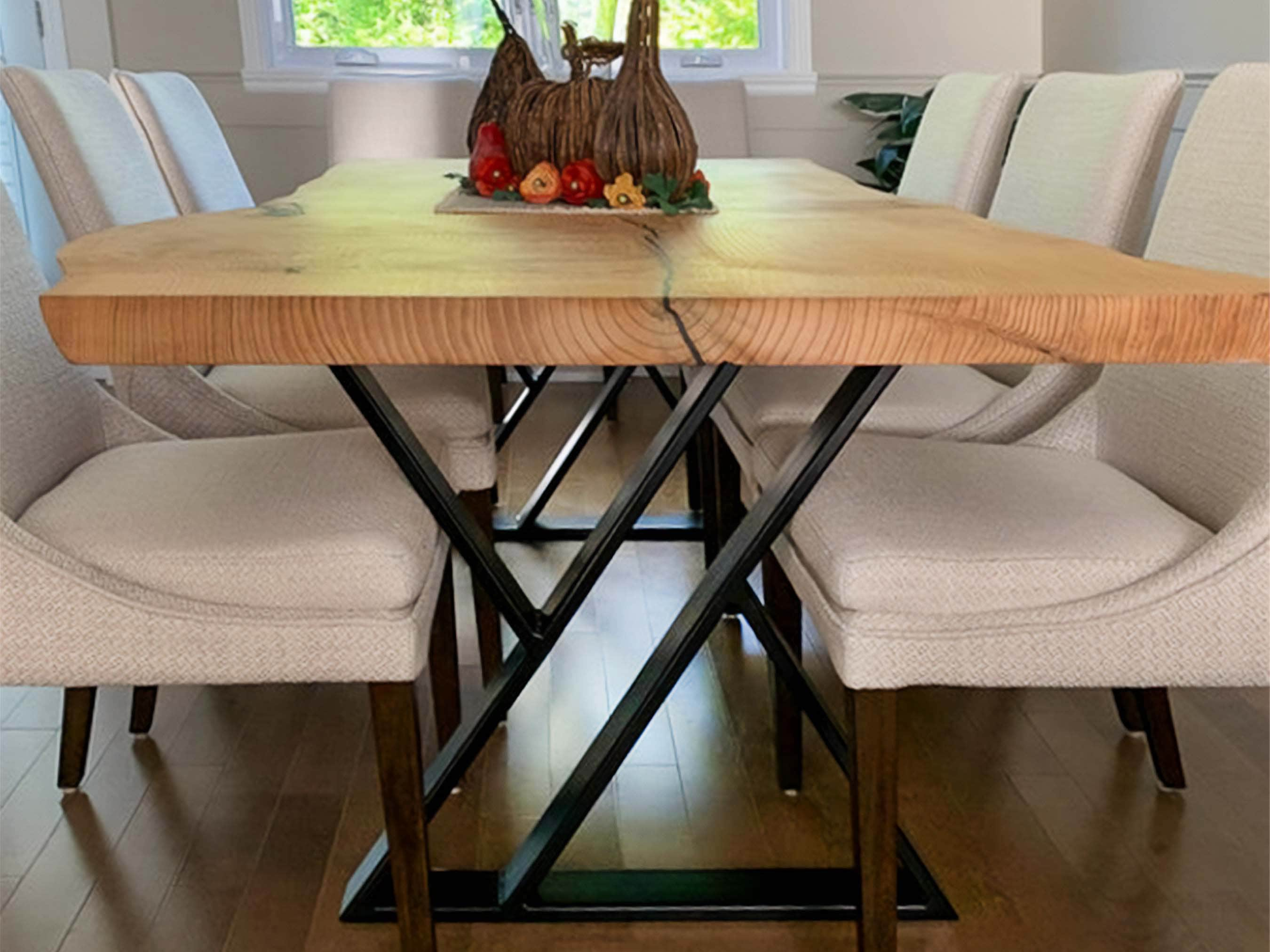From Standard to Modern: Find the Perfect Dining-room Table Legs for Your Style
The choice of eating room table legs plays a crucial function in specifying the total character of your room, connecting the space in between conventional workmanship and contemporary visual appeals. While timeless styles such as cabriole and transformed legs evoke a feeling of timeless class, contemporary styles like barrette and geometric options offer an opportunity for striking aesthetic passion. Examining the right balance in between these styles needs a nuanced understanding of your existing décor and individual preference. As you think about these components, the question stays: just how can you seamlessly integrate these varied leg designs to create a harmonious dining experience?
Recognizing Table Leg Styles
The selection of dining-room table leg designs can significantly affect both the visual appeals and functionality of the space. Each leg style adds one-of-a-kind functional functions and visual elements, accommodating varied layout choices and usage requirements. Understanding these designs is critical for picking the ideal table that aligns with your total indoor style vision.
As an example, conical legs use a tidy, traditional look that can boost a space's sophistication, while stand bases supply security and make the most of legroom, making them perfect for smaller sized areas. Hairpin legs, a characteristic of mid-century contemporary design, present a commercial flair, permitting for an airy, open feel. In a similar way, trestle legs evoke rustic beauty, supplying robust assistance and a sense of eternity.
Wood legs can bring warmth and structure, whereas steel options typically share a sleek, contemporary ambiance. Inevitably, understanding table leg styles is necessary for developing a cohesive dining area that reflects individual style while making sure practicality and comfort.
Standard Table Leg Options
When picking dining-room table legs, conventional choices often embody ageless sophistication and workmanship. These layouts mirror an abundant heritage and a dedication to quality, making them perfect for those who appreciate traditional appearances.
Among one of the most iconic traditional leg designs is the cabriole leg, identified by its elegant bent form. This style commonly includes attractive makings and is most frequently discovered in Queen Anne and Chippendale furniture. One more prominent option is the turned leg, which flaunts a collection of smooth, rounded forms that supply a traditional look while preserving stability.
Furthermore, the straight leg, while simple, offers a sturdy and basic structure that can blend flawlessly with a selection of tabletop designs. For those attracted to ornate describing, claw-and-ball feet legs evoke a sense of grandeur and can act as a magnificent focal factor in any type of eating space.
Last but not least, stand bases, although not strictly legs, provide a different standard choice that permits enough legroom and can be magnificently carved. Each of these typical leg designs adds to the overall setting of a dining area, weding feature with aesthetic allure.

Modern Table Leg Designs
Modern table leg styles offer a varied series of designs that emphasize tidy lines and innovative products. These styles frequently focus on functionality while functioning as striking prime focus within a dining room. Minimalist looks prevail, with legs crafted from products such as steel, glass, and engineered timber, which add to a airy and modern feeling.
One preferred design is the barrette leg, identified by its slender, tapered framework that provides stability without frustrating the table top (dining room table legs). This style is typically located in mid-century modern furniture and can easily enhance different table forms. Another pattern is making use of geometric forms, where legs might take on asymmetrical or angular types, including aesthetic interest and a touch of creativity

Blending Styles for Unique Rooms
Usually, home owners look for to produce distinct dining spaces that reflect their individual design by blending various layout components. This technique enables for the incorporation of varied appearances, causing a harmonious yet distinctive setting. For circumstances, matching a rustic wood table with streamlined, contemporary steel legs can produce an appealing contrast that boosts the space's overall charm.
Additionally, incorporating vintage table legs with contemporary table tops can evoke a feeling of history while keeping a modern perceptiveness. Such mixes not just showcase private taste however also motivate creative thinking, enabling homeowners to curate an area that really feels both personal and welcoming.
Shade plays a vital duty in this blending procedure; selecting table legs that match or comparison with the existing color design can boost visual passion. For instance, whitewashed legs can soften the boldness of a dark table surface, creating a balanced visual.
Tips for Picking the Right Legs
Selecting the right table legs is vital for attaining both functionality and visual allure in your eating space. Begin by thinking about the total design of your room. Conventional setups take advantage of legs that include intricate carvings or turned styles, while modern rooms might call for sleek, minimalist styles.
Next, examine the elevation and security of the legs. dining room table legs. Standard table range between 28 to 30 inches in height, so guarantee the legs match this dimension for convenience. Furthermore, durable products, such as wood or steel, can improve security and durability
Examine the leg form also-- choices consist of right, tapered, or stand layouts. Straight legs supply a timeless appearance, while conical legs can include a touch of style. Pedestal bases give enough legroom and are excellent for smaller sized rooms.
Verdict
In recap, choosing the optimal dining-room table legs requires mindful factor to consider of both contemporary and conventional styles. Typical alternatives such as cabriole and transformed legs provide timeless elegance, while modern-day styles like hairpin and geometric shapes give a modern touch. By balancing leg style, elevation, and material with the overall décor, a cohesive and welcoming atmosphere can be accomplished. Ultimately, the picked table legs must mirror the preferred aesthetic, boosting the dining experience within the space.
The selection of dining area table leg styles can dramatically influence both the aesthetics and capability of the space. Inevitably, understanding table leg designs is important informative post for developing a cohesive dining location that reflects individual design while guaranteeing functionality and comfort.One of the most have a peek at these guys legendary conventional leg designs is the cabriole leg, characterized by its stylish bent shape. Straight legs use a timeless look, while conical legs can include a touch of elegance.In summary, picking the perfect eating area table legs requires cautious factor to consider of both contemporary and typical styles.